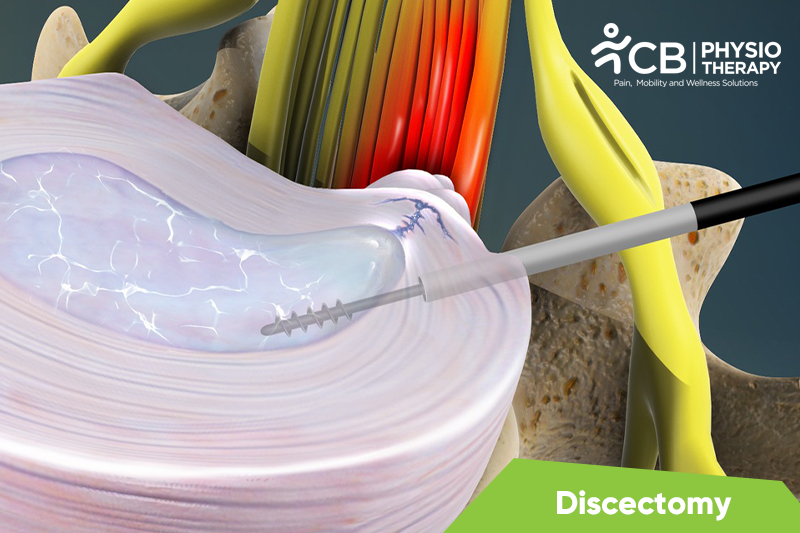
Discectomy is the surgical removal of part or all of a bulged or herniated intervertebral disc that presses against a nerve root or the spinal cord causing pain and other symptoms. Surgery is done to achieve decompression by removing the soft tissue or bone and compressing the contents of the spinal canal. Surgery is done to reduce pain if the herniated disc is unresponsive to conventional treatment.
Types of discectomy:
Discectomy is indicated for radicular pain unresponsive to conservative management therefore surgery is recommended to reduce the pain and regain mobility and function. Other causes may be:
Pathology
The spine or vertebral column is composed of bones (vertebrae), which rest one on top of the other. In between these vertebrae are discs that provide support by their cushioning effect and also allow the vertebral column to bend. However, when the disc becomes diseased, it can become bulged or herniated, thus causing the compression of the spinal nerves. This causes localized neck pain, back pain, or radiating pain, such as sciatica that spreads down one or both legs. In such cases, the disc needs to be removed by surgery.
X-rays:
X-rays help to determine the extent to which the bone is damaged.
MRI:
MRI helps to determine the disc, bone, muscular or ligamentous damage.
Medication: Anti-inflammatory drugs, painkillers, etc.
Note: Medication should not be taken without the doctor's prescription.
Cold therapy can be used to decrease spasms and inflammation.
Heat therapy can be given to increase blood circulation and drain out toxins.
EMS:
Electrical muscle stimulations are recommended to strengthen the weak muscles.
Braces:
The patient should continue to wear the braces and should resist picking-up objects from the floor by bending at the waist, carrying heavy objects must be avoided.
Walking:
Walking increase blood flow throughout the body and helps to build cardiovascular endurance. Because of the increased blood flow, more nutrients and oxygen are brought to the tissues to help the patient heal. Climbing stairs should be climbed once daily. Walking helps regain mobility quicker and also reduces the chances of scar tissue formation.
Range of motion Exercises:
Simple range of motion exercises is done to maintain mobility and functionality.
Strengthening exercises aim to provide light strengthening to the spine and improve the patient's tolerance with 30 minutes of cardio each day. These exercises strengthen the muscles around the disc and also increase flexibility. The strength is achieved with graduated, repetitive exercises targeting the lower back muscles. Prone and supine leg raises are strengthening exercises due the lower back and the abdominal muscles exercises like prone leg raise, supine leg raise, for strengthening the spine flexors, alternate knees to the chest exercises can be done, for strengthening the core muscles involves flattening the lower back to touch the ground while lying on the back with the knees bent should be done under the supervision of the physiotherapist.
Stretching Exercises:
Stretching exercises help in releasing muscular spasms and soft tissue restrictions. Exercises include walking, light stretching, isometrics with multifidi and glute sets, transverse abdominal bracing, etc, these exercises increase the flexibility of the targeted muscles.
Maintenance of the Posture:
The physiotherapist helps to improve posture and gait. Proper posture is necessary to prevent excess strain on the ligaments and also to prevent muscle deconditioning. Initially, sitting posture may be difficult, the sitting period can be 20 minutes initially, which can be increased gradually.
Cardio Exercises:
Cardio exercises involve walking progression and stationary bike workout whereas light strengthening exercises include transverse abdominal, glute activation, and upper and lower extremity strengthening. Hydrotherapy is also imparted for strengthening the upper and lower extremities.
Patients should quit smoking before surgery as it will not only be beneficial for health in general but will also accelerate the healing process after surgery. Exercises should be done as recommended by the physiotherapist. Do exercises after the surgery as per the doctor's advice as exercises help to slowly regain spine flexibility and improve mobility. Also, strenuous exercises should be avoided, mild aerobic exercises like walking are encouraged, but without putting strain on the body by lifting heavy objects or any form of strenuous exercise.
Select your City to find & connect with our experts regarding Physiotherapy for Discectomy